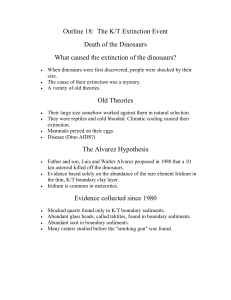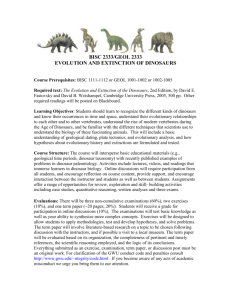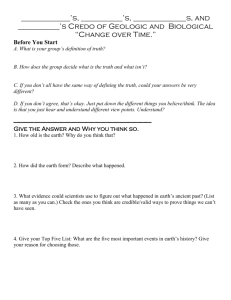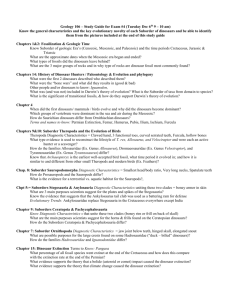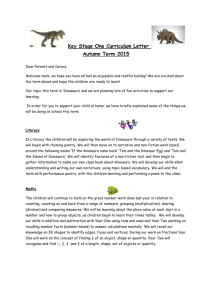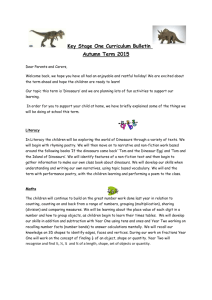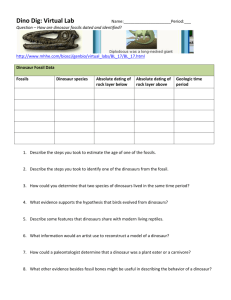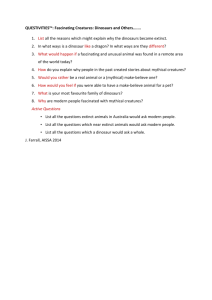Word
advertisement
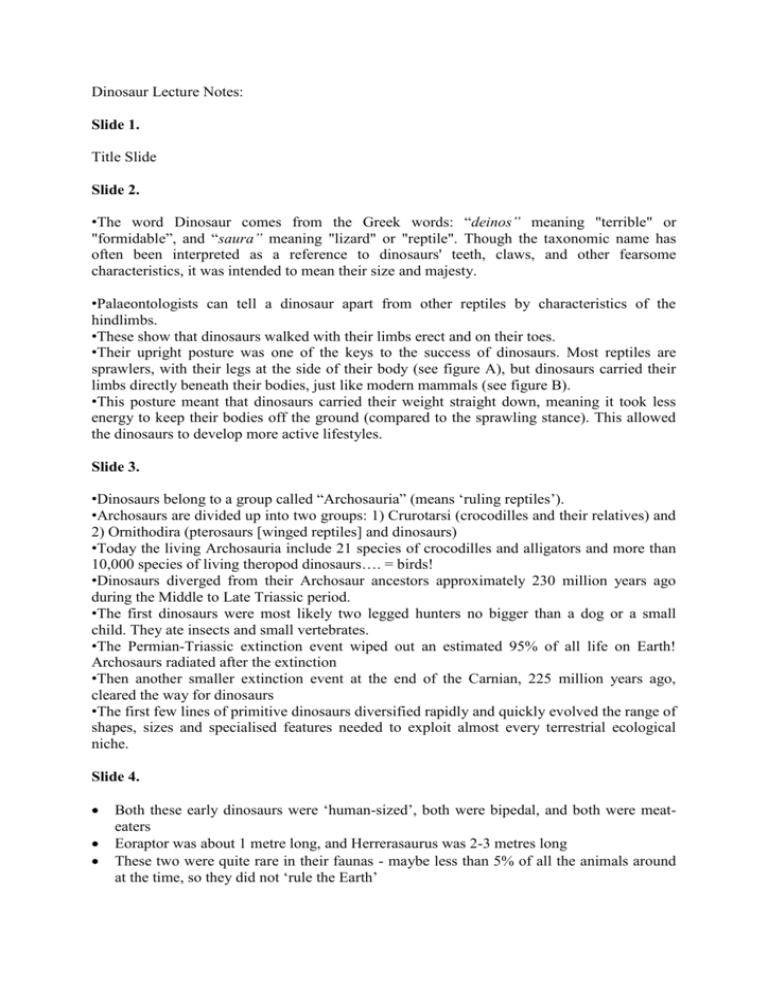
Dinosaur Lecture Notes: Slide 1. Title Slide Slide 2. •The word Dinosaur comes from the Greek words: “deinos” meaning "terrible" or "formidable”, and “saura” meaning "lizard" or "reptile". Though the taxonomic name has often been interpreted as a reference to dinosaurs' teeth, claws, and other fearsome characteristics, it was intended to mean their size and majesty. •Palaeontologists can tell a dinosaur apart from other reptiles by characteristics of the hindlimbs. •These show that dinosaurs walked with their limbs erect and on their toes. •Their upright posture was one of the keys to the success of dinosaurs. Most reptiles are sprawlers, with their legs at the side of their body (see figure A), but dinosaurs carried their limbs directly beneath their bodies, just like modern mammals (see figure B). •This posture meant that dinosaurs carried their weight straight down, meaning it took less energy to keep their bodies off the ground (compared to the sprawling stance). This allowed the dinosaurs to develop more active lifestyles. Slide 3. •Dinosaurs belong to a group called “Archosauria” (means ‘ruling reptiles’). •Archosaurs are divided up into two groups: 1) Crurotarsi (crocodilles and their relatives) and 2) Ornithodira (pterosaurs [winged reptiles] and dinosaurs) •Today the living Archosauria include 21 species of crocodilles and alligators and more than 10,000 species of living theropod dinosaurs…. = birds! •Dinosaurs diverged from their Archosaur ancestors approximately 230 million years ago during the Middle to Late Triassic period. •The first dinosaurs were most likely two legged hunters no bigger than a dog or a small child. They ate insects and small vertebrates. •The Permian-Triassic extinction event wiped out an estimated 95% of all life on Earth! Archosaurs radiated after the extinction •Then another smaller extinction event at the end of the Carnian, 225 million years ago, cleared the way for dinosaurs •The first few lines of primitive dinosaurs diversified rapidly and quickly evolved the range of shapes, sizes and specialised features needed to exploit almost every terrestrial ecological niche. Slide 4. Both these early dinosaurs were ‘human-sized’, both were bipedal, and both were meateaters Eoraptor was about 1 metre long, and Herrerasaurus was 2-3 metres long These two were quite rare in their faunas - maybe less than 5% of all the animals around at the time, so they did not ‘rule the Earth’ Slide 5. The age of dinosaurs came after a long history of the Earth and evolution. If you think about the history of the Earth as just one 24-hour day, then life appeared at 6 o’clock in the morning, the first fishes at 9 in the evening, and the first dinosaurs at 10.30 in the evening. Humans appeared about five minutes before midnight! Slide 6. •The Mesozoic Era is often called the “Age of the Dinosaurs” because for more than 150 million years a single, extremely diverse group of reptiles (the dinosaurs) dominated life on land. •The Mesozoic Era contains the perhaps more familiar Triassic, Jurassic and Cretaceous periods. •During this period of dinosaur predominance, which encompassed the Jurassic and Cretaceous periods, nearly every known land animal larger than 1 meter in length was a dinosaur. •During the Paleozoic (542-251 million years ago) and Mesozoic (250-65 million years ago) Eras the Earth’s continents formed a singe land mass (a supercontinent) called Pangea (pictured left of screen). •Pangaea is believed to have broken up about 180 million years ago in the Jurassic Period, first into two supercontinents (Gondwana to the south and Laurasia to the north), thereafter into the continents as we understand them today (see animation). •The fact that all the continents were joined together explains why we see the same kinds of dinosaur fossils on different continents today. Slide 7. •There are over 950 known species of dinosaur!! •These can be divided into two groups: •The SAURISCHIA (reptile hipped) dinosaurs - the flesh-eating THEROPODS and the long necked (usually large) plant-eating SAUROPODOMORPHS •The ORNITHISCHIA (bird hipped) dinosaurs - all plant-eaters, including the two-legged ORNITHOPODS and the various armoured forms Slide 8. The six or seven major dinosaur groups can be shown in a CLADOGRAM - a simple branching tree that represents closeness of relationship. [Silesaurus is a dinosauromorph - a dinosaur-like animal (nearly, but not quite, a dinosaur) from the Late Triassic of Poland] Slide 9. Theropods ranged in size from animals like Compsognathus, the size of a turkey, to the awesome Tyrannosaurus rex, weighing five tonnes or more - the largest meat-eating animal ever; the largest biped - just imagine the biggest elephant balanced up on two legs! They all ate meat, using their sharp teeth to tear the flesh. The teeth kept growing, so if a few snapped off, more grew up from below. They could grab and grapple with prey with their hands. Slide 10. The first sauropodomorphs were the prosauropods, known from the Late Triassic and Early Jurassic - such as Plateosaurus. These ranged from human-sized up to 7 metres long. Replaced by sauropods in the Early and Middle Jurassic - these were the real giants, some up to 30 metres (100 feet) long, and weighing 50 tonnes - such as Diplodocus, Apatosaurus, and the tall Brachiosaurus. Picture shows Diplodocus. Slide 11. Ornithoipods were all bipeds and all plant-eaters. Known from Early Jurassic to end of Cretaceous. The early ones, like Heterodontosaurus, were quite small. Early Cretaceous forms included Hypsilophodon (bottom right) and the large Iguanodon with its thumb spike. In the Late Cretaceous, hadrosaurs (duckbills) dominated - with huge herds of these 5-10 metre long dinosaurs munching aeverything thewy saw. They had multiple banks of teeth, up to 500 per jaw (2000 in all). Head crest of Parasaurolophus (left) is not a snorkel, but used as a resonating chamber - its breathing tubes ran up from the nostrils to the tip of the crest, and down the throat. Could puff air out through this making honking noise. Purpose: ?species recognition, mating? Males, females and juveniles all probably honked and tooted at different pitches. Slide 12. The armoured dinosaurs: Ceratopsians = ‘horned faces’ like Triceratops Ankylosaurs (knobbly skins and tail clubs - shown here) Stegosaurs such as Stegosaurus (plated backs) Best known from Jurassic (esp. stegosaurs) and Cretaceous (esp. ankylosaurs, ceratopsians) Slide 13. •Pterosaurs are sometimes referred to in the popular media as dinosaurs, but this is incorrect. •The term "dinosaur" is exclusively restricted to terrestrial reptiles with a unique upright stance (the superorder Dinosauria), and therefore excludes the pterosaurs •Pterosaurs had their wing supported along the back of the arm and the extended fourth finger •Their skin was covered with short hairs, especially over the back, so fully warm-blooded (high metabolic rate needed for flight) •Could fly properly, just like a bird or bat We know they had a flight membrane - often preserved in exceptional specimens, made of elastic, strengthened skin Slide 14. These are also not dinosaurs, the marine reptiles: ichthyosaurs, plesiosaurs, and mosasaurs. Three ichthyosaurs shown here (one fossil, top right) and two reconstructions (top left, bottom right). Huge eyes (vision in murky water), dolphin-like body, swam bt lateral beating of tail abd body, and steered with paddles (modified legs). Produced live young at sea. Plesiosaurs (bottom left) had long necks (plesiosauroids) or short necks (pliosaurs; shown here). They came out on to land to lay eggs. Origin of Loch Ness Monster stories? Slide 15. The first mammals arose about 220 million years ago, about the time of the first dinosaurs. Remained small, shrew-sized insect-eaters through the Mesozoic. Some larger ones towards the end of the Cretaceous - maybe cat- or badger-sized. Slide 16. Shift to calculations in Exercise 1. Point is to work out whether dinosaurs could just have gone on growing bigger and bigger. The largest reasonable estimated body mass is 50 tonnes for the sauropod Brachiosaurus. Could there have been a 100-tonne dinosaur, a 200-tonne dinosaur, even one weighing 1000 tonnes? Is there a limit on size? If so, what are likely limiting factors, and how can these be used to estimate the absolute maximum size? Slide 17. One of the big debates in the past thirty years… indeed, this has been an issue since dinosaurs were first discovered: were these huge and extraordinary creatures cold-blooded like modern lizards and crocodiles, or warm-blooded like living mammals and birds? Slide 18. What do we mean when we say an animal is warm-blooded or cold-blooded? When we say “cold-blooded” we really mean “Ectothermic”. This means that the animal relies on heat from outside it’s body (from the environment) to maintain its body temperature. Like a lizard or snake will bask in the sun in the mornings to heat up before it goes hunting. [ecto = outside] When we say “warm-blooded” we really mean “Endothermic”. This is when the animal relies on heat generated within its own body, or its metabolism. For example, mammals like us. [endo = inside] For simplicity we usually just use warm- or cold-blooded. Slide 19. •Once it was thought that all dinosaurs were cold-blooded (like the retiles we see today) •Now many scientists suggest that at least some were warm-blooded. •If dinosaurs were cold-blooded, they would have had to warm themselves in the sun as reptiles do today. However, if they were warm-blooded like birds and mammals, they would not have needed to warm themselves and could have remained active, even in low temperatures. •To some scientists this helps to explain why dinosaurs became so plentiful and dominant for such a long period of time. •If we look at the animals alive today there are no large predators that are cold-blooded. Except for crocodiles that occupy only one very specific ecological niche. •We know that some dinosaurs (birds) were and are warm-blooded (endothermic) but at what point dinosaurs evolved endothermy is a difficult question. Slide 20. There are many lines of indirect evidence used to infer whether or not a dinosaur was “warmblooded”. 1) Bone structure and histology: •Endothermic animals have a complex bone structure made up of closely spaced cavities caused by the growth and resorption of bone. This is called the Haversian System (see Haversian Canals in Figures). The exact function of this system is unknown, but one idea is that the Haversian System allows bones to be remodeled quickly. This means that endothermic animals can change quickly in size and shape during growth. •In slow growing animals collagen fibers that make up the bone are laid down parallel to each other, called “lamellar” bone. In fast growing animals the collagen is laid down in random orientations forming a “woven” bone. •“Woven” bone is typical of mammals and birds that are warm-blooded and hence fast growing. Whereas, cold-blooded, slow growing reptiles typically have “lamellar” bone. •One way to test for endothermy in dinosaurs is to cut the fossil bones into very thin slices and compare them under a microscope to bones of living animals whose temperature control system is known. •Of the hundreds of tests done, in most nonavian (not birds) dinosaurs the microstructure of the fossil bone appears more like that of endothermic animals. I.e. it is “woven” bone with Haversian Canals. •However, continuing studies have complicated the interpretation of these results. Many small mammals and birds do not show either Haversian canals or lamellar bone, and at least one turtle has been found with a dense Haversian bone. •Also, to standardise the observations we should compare animals of a similar size. There are no nonavian dinosaur-sized ectothermic animals alive today to compare with. So studies have focus only on small dinosaurs. Slide 21. 2) A second line of evidence for endothermic dinosaurs comes from inferred behaviour and community structure. •For example, there is a theory that dinosaurs were highly active animals, similar to modern mammals. This is suggested by the structure of many dinosaurs, e.g. the long, ostrich-like legs of ornithomimids (see figure on right), suggest active behaviours like running. This behaviour would require a high metabolic rate, such as found in endotherms. •This is however, perhaps over-interpretation of the available data. Can we ever know for sure how dinosaurs actually behaved using fossilised remains and traces? Slide 22. 3) The relative number of predators to prey in an ecological community may provide insight into an animal’s metabolism. •In modern ecosystems predators with a constantly high metabolism (endotherms such as lions) need to eat a lot more than predators with a lower metabolic rate (ectotherms such as komodo dragons). Therefore, proportionally there are more prey species in communities dominated by endothermic predators. Think about how many zebras, antelope, wildebeest (heribovores = plant eaters). there are on the African plains compared to lions, cheetahs, leopards (carnivores = meat eaters). •Some palaeontologists have tried to apply this theory to dinosaur communities found at particular locations. They have discovered that in some (but not all) fossil locations show a fewer amount of carnivorous (predatory) dinosaurs than herbivorous (prey) dinosaurs. This suggests that at least the predatory dinosaurs were endothermic. •There is a problem with this interpretation however, as we cannot be certain that the fossil record accurately preserves relative proportions of species. Do the ratios of different types of fossils have more to do with variations in preservation rather than original numbers of dinosaurs? Slide 23. 4) “Cold-blooded” ectotherms, by prediction and by observation of modern examples, do not do well in extreme cold. •Late Cretaceous faunas have been discovered from a number of locations in Alaska and other Arctic areas that were deposited when average annual temperatures ranged between 2 and 8 degrees C. These deposits are notable for the almost complete absence of known ectotherm species such as crocodiles that are normally abundant in comparable North American ecosystems from warmer climates. •However, these deposits contain large numbers of dinosaurs. •If the dinosaurs were also ectotherms, why did they thrive whilst other forms of ectotherms could not survive? •In Arctic and Antarctic conditions there would be long periods of little to no sunlight and low temperatures. How did the dinosaurs cope with these conditions? Some scientists believe it was because they were warm-blooded and able to remain active during the Winter months. •Others remind us that there were no ice caps at the poles in the Mesozoic, and that the dinosaurs might have been ectothermic and migrated long distances to feed near the poles in summer, and in warmer climes in winter Slide 24. Some scientists believe that dinosaurs did not need to be warm-blooded (endothermic) to develop into all the different sizes and shapes we have discovered and live in a variety of environments. The main lines of evidence and the problems encountered are as summarised: 1)Dinosaur size. •Dinosaurs were quite large. So the hypothesis is that they did not need to be endotherms; they could be “inertial homeotherms” meaning they would warm up slowly and cool very slowly, so they could maintain a near-constant body temperature. •The problem with this argument is that not all adult dinosaurs were large! Their weight range was from about 10 pounds (5 kg) to 80 or so tons. Even the largest dinosaurs would have had small babies. Also, there are large mammals (e.g., whales and elephants), which are endotherms, not inertial homeotherms. 2) Mesozoic climate •The climate of the Mesozoic era was mild and warmer than today. Therefore the theory is that dinosaurs did not need to be endothermic; it was always warm enough to keep them warm and active. •The argument against this is that the climate in the Mesozoic era was varied, and dinosaur fossils are found in some areas that were cooler and less mild then, including polar regions (as was shown as evidence for endothermic dinosaurs). 3) Scales •Modern ectotherms are generally scaly (e.g. snakes, crocodiles). As dinosaur fossilized skin impressions show somewhat scaly hides, some scientists believe that this means they were ectotherms. •The problem with this is that birds (which are endotherms) are scaly too! Look at their legs; these scales are indicative of their archosaurian ancestry. Bird feathers are modified scales. •Also, there are few known dinosaur skin impressions, so we don't know what the skin of most dinosaurs was like. Most endotherms do have fur or feathers for insulation, though. 4) An absence of Respiratory Turbinates •We know that all modern terrestrial endotherms have Respiratory Turbinates. These are folded bones in the sinuses, which are important in conserving water loss in endothermic animals. Some palaeontologists believe that dinosaurs did not have respiratory turbinates, so they could not have functioned as endotherms. •However, it has not yet been conclusively shown that no dinosaurs at all had turbinates. So far there has only been a few studies looking for these structures in dinosaurs. •We know that many birds have Respiratory Turbinates, so they must have evolved in birds sometime (perhaps in the Mesozoic?). Slide 25. Presenter: Ask the students if they prefer one side of the argument to the other before clicking to get the summary. Slide 26. How on Earth could we ever find out how fast an extinct animal could run? We’ll never be able to time one of them as it hurtles by - what if they all moved very slowly, as in old Hollywood movies? Think about fossil trackways… Slide 27. •There have been many mass extinctions throughout the history of the Earth. Probably the most famous one though, is the extinction that saw the end of the dinosaurs reign on the Earth, 65 million years ago (The Cretaceous-Tertiary Extinction Event)….. Slide 28. •The Cretaceous-Tertiary extinction event was the large-scale mass extinction of animal and plant species in a geologically short period of time, approximately 65 million years ago. •It is widely known as the K-T extinction event (K is the traditional abbreviation for the Cretaceous Period, and T is the abbreviation for the Tertiary Period). •It wasn't just the dinosaurs that died out in this extinction. Whatever caused the death of the dinosaurs also caused the death of around 70% of all of the species on the Earth. •There are a number of theories about what caused this mass extinction and many scientists theorize that the K-T extinctions were caused by one or more catastrophic geological events such as massive asteroid impacts or increased volcanic activity. Several impact craters and massive volcanic activity in the Deccan traps (volcanic lava flow deposits found in India) have been dated to the approximate time of the extinction event. •These geological events may have reduced sunlight and hindered photosynthesis, leading to a massive disruption in Earth's ecology. Other researchers believe the extinction was more gradual, resulting from slower changes in sea level or climate. •Here we will weigh up the evidence for an asteroid impact event… Slide 29. •In 1980, a team of researchers consisting of Nobel prize-winning physicist Luis Alvarez, his son, a geologist called Walter Alvarez, and chemists Frank Asaro and Helen Michels discovered that sedimentary rock layers found all over the world at the Cretaceous-Tertiary boundary contain a concentration of iridium many times greater than normal. •Iridium is extremely rare in the earth's crust, but iridium remains abundant in most asteroids and comets. •Based on this the Alvarez team suggested that an asteroid struck the earth at the time of the K-T boundary. •The consequence of an impact would be a dust cloud which would block sunlight and inhibit photosynthesis for a few years. This would account for the extinction of plants and phytoplankton and of all organisms dependent on them for food (including herbivores and the predatory animals that feed on them). However, small creatures whose food chains were based on detritus (dead organic material) might have still had a reasonable chance of survival. Slide 30. •Alvarez et al. (1980) predicted that an asteroid large enough to wipe out the dinosaurs would produce a 100-150 km wide crater. •Research has identified the Chicxulub Crater buried under Chicxulub on the coast of Yucatan, Mexico as the impact crater, which matched the Alvarez hypothesis dating. •Identified in 1990 this crater is oval, with an average diameter of about 180 kilometers (112 miles) •The shape and location of the crater indicate further causes of devastation in addition to the proposed dust cloud. The asteroid landed right on the coast and would have caused gigantic tsunamis •Evidence has been found all round the coast of the Caribbean and eastern United State of tsunami’s dated at the time of the K-T extinction. This evidence includes marine sand in inland locations and vegetation, debris and terrestrial rocks in marine sediments dated at the time of the impact. •The asteroid landed in a bed of gypsum (calcium sulphate), which would have produced a vast sulphur dioxide gas cloud. This would have further reduced the amount of sunlight reaching the earth's surface and then produced acid rain, which would kill vegetation, plankton and organisms, which build shells from calcium carbonate. • The crater's shape suggests that the asteroid landed at an angle of 20-30 degrees from horizontal and traveling towards the northwest. This would have directed most of the blast and solid debris into the central part of what is now the United States of America. Slide 31. •Most palaeontologists now agree that an asteroid did hit the Earth about 65 million years ago, but there is an ongoing dispute whether the impact was the sole cause of the extinctions. •The impact clearly would have killed any dinosaur standing in direct line of fire… But what about worldwide? Dust cloud and blanking of sun (darkness and icy cold) Slide 32. Lots of beasts survived the KT event - frogs, lizards, snakes, crocodiles, birds, mammals… But would the mammals have taken over the world 65 million years ago if the dinosaurs had not been cleared aside? Slide 33. Presenter: Read through the summary notes.

